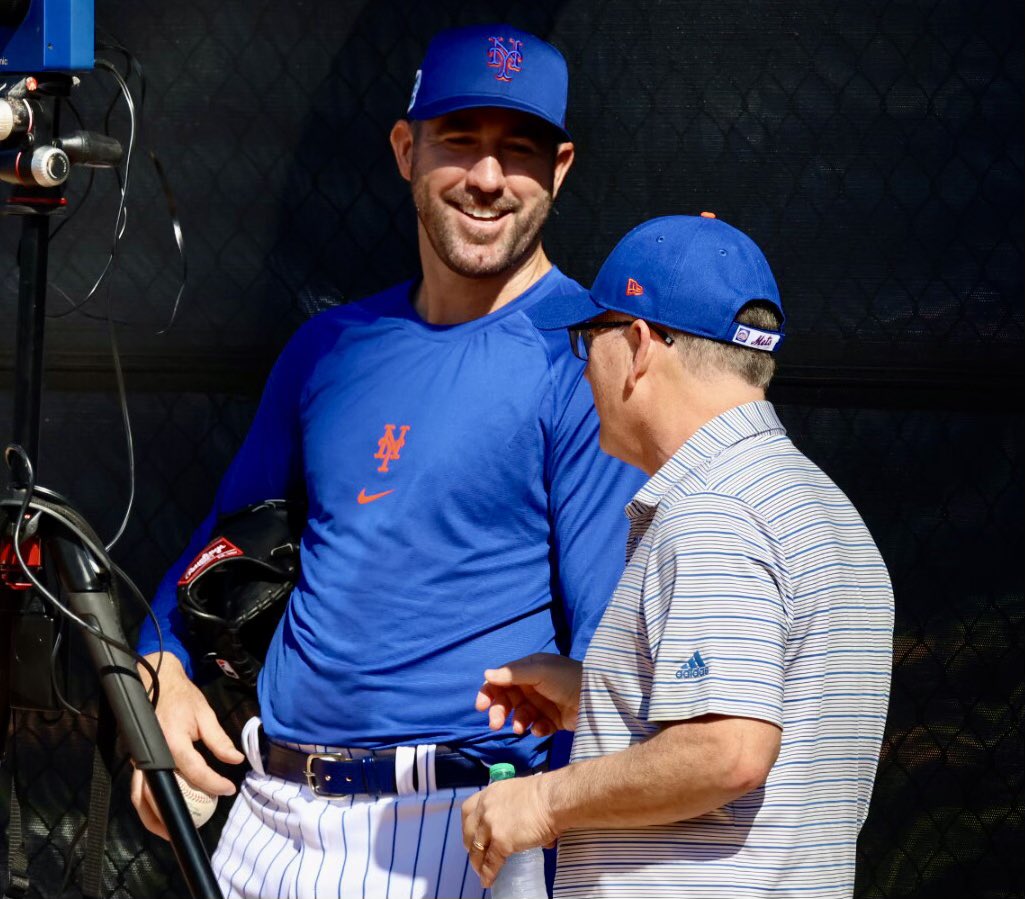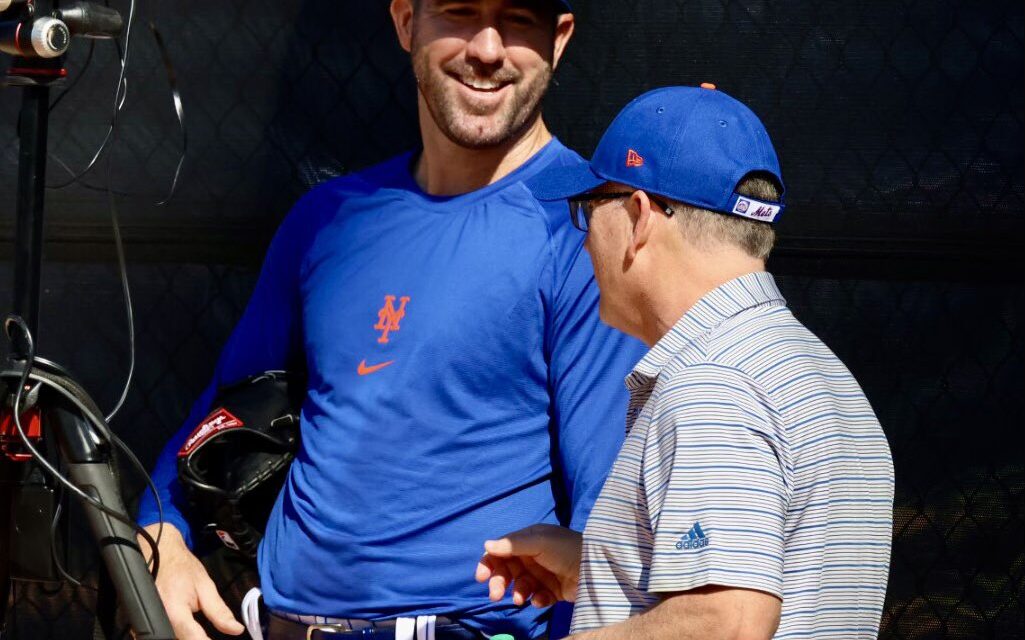
Justin Verlander and Steve Cohen, Photo by Ed Delany
It’s been well documented that 2023 will be a year of significant on-field changes for Major League Baseball. This season, we will see the debut of larger bases, pitch clocks, and shift restrictions, as well as an encore performance of increased enforcement of the balk rule.
Now, MLB has taken a step toward what may be sweeping changes in the game’s revenue structure and is planting seeds that the idea of a salary cap may be back on the table for the next round of collective bargaining agreement negotiations before the 2027 season.
Local Broadcasting Rights May Change
Let’s start with possible changes in how teams earn television money. There are two components to this. Teams share national television income equally, as networks pay for broadcast rights to the postseason, weekly national telecasts (FOX, ESPN, TBS), and the All-Star game. Clubs then sell the broadcast rights to the remainder of their games to local sports networks, and the amount of revenue available from this varies significantly by market size and the terms of the negotiated contract.
In an article in The Athletic by Evan Drellich, the author discusses that owners, while most are never happy with the disparity in local income, have become even more frustrated lately as the gulf between the revenues of large and small market teams has recently widened. Now there is a new element in the mix. Diamond Sports Group, which carries Bally’s regional sports networks (RSNs), may soon file for bankruptcy. DSG bought the local rights to the games of 14 MLB teams: the Atlanta Braves, Arizona Diamondbacks, Cincinnati Reds, Cleveland Guardians, Detroit Tigers, Kansas City Royals, Los Angeles Angels, Miami Marlins, Milwaukee Brewers, Minnesota Twins, San Diego Padres, St. Louis Cardinals, Tampa Bay Rays and Texas Rangers.
If DSG does file for bankruptcy, Commissioner Rob Manfred has decreed that the show must go on. From the cited article, Manfred recently said, “We got to find a new model. Maybe we ought to be driving the boat, what that model looks like. So, that’s the new challenge.” The reference here is that MLB may step in to ensure its product is available for fans, and generating local revenue. To do this, MLB may take on the task of digitally producing the games and securing local advertising dollars, then centrally (and equitably) distributing those revenues to the teams whose games are in scope.
Bingo! In the eyes of MLB, a DSG bankruptcy may be a blessing. For at least many teams, local income can be even, and literally put them on the same financial playing field. (No one has figured out if teams will actually spend that money on players in the same way, but one thing at a time). From the article, here’s Manfred’s summary: “I think that people see it as an opportunity to rethink the revenue side of the house a little bit, which has been hard in our sport. People entrenched in their local (media dynamics).”
An Economic Reform Committee
Evening out revenue may be only the tip of the economic change iceberg. MLB has recently put together an “economic reform committee.” The idea, according to Manfred, is the get the thirty teams talking to each other about what does and does not work in the game. Mark Walter of the Dodgers is reportedly chairing the economic reform committee. Chris Ilitch of the Tigers, John Henry of the Red Sox and Dick Monfort of the Rockies are among the members of the new committee as well.
From the outside, it seems that this committee is getting ready to propose an economic overhaul to the players in the next CBA negotiations after the 2026 season. It could be a more complete revue-sharing model (teams share only a portion of revenues now), or all of this could be setting the stage for the owners to insist on a salary cap (which seems more and more likely). The players have adamantly refused to even consider a cap in the past, and would likely take that position again, even if the owners included a proposal for a spending floor. It all seems to add up from the owners’ side. More teams share revenues, then all cooperate on the distribution side via a cap. This could be baseball Armageddon on the horizon.
Manfred’s quote from the article makes all of this sound like more than just speculation.
“When you start thinking about the opportunities in terms of a more national (broadcasting) product, it did lead into a conversation about our disparity issues on the revenue side,” Manfred said. “We have businesses that are literally not similar in terms of the overall revenue that they’re generating. And to the extent that you could find a new distribution model that actually helped on that disparity side, that would be the daily double. So people are having conversations that haven’t been had in baseball, and it’s really been owners talking to owners, which is a good thing.”
How much does Mets’ owner Steve Cohen, and his aggressive spending, factor into this? The Mets’ current payroll projection is $370 million, an MLB record and well past the final tier for the highest luxury tax, which this year is $293 million. The commissioner may be acting now via the committee to get as many owners on board for a cap as possible. There needs to be 23 owners in favor to make a salary cap proposal. Then, of course, the players need to agree. Drellich quotes a Steve Cohen rival executive as saying:
“Owners are now beginning to dislike each other, not just personally, but the economics of the game is something that you’re gonna have to work through. But it’s not coming till ’26. They’re not reopening the collective bargaining agreement. But … they’re working on the new CBA. Now.
“And that may sound early to you, but it’s not. And the reason they’re working on it now is they’ve got to come up with solutions to get to 23 (votes). Because if they had a vote on a CBA today, given what Steve Cohen’s done, given what the league looks like, here’s a little terrible fact: They don’t have the votes. And that’s a scary thing if you’re the commissioner.”
Would Cohen support a salary cap in baseball? From Tim Healy on Twitter:
Would Steve Cohen support a salary cap?
Cohen: "I’m not going to say for now. I would need to understand the underlying rules behind it. But the answer is I’ll make that decision when we get there."
— Tim Healey (@timbhealey) February 20, 2023
Here’s a quick summary:
- MLB may start regulating local television revenue by taking over broadcast rights if a large RSN group defaults on its payments, resulting in bankruptcy.
- MLB wants to change and standardize local revenue (the above gives the opportunity on a large scale), and may seek to standardize financial distribution to the players (i.e. salary cap).
- Steve Cohen may be the impetus for moving on these changes, which have been sought for a while.
- Let’s hope all of this is figured out by 2027, because the owners are moving toward a salary cap, which would make prior labor disputes seem like petty squabbles.
The actual fight–between owners themselves and between owners and players–around MLB’s economic structure is years away, but the warm-up for that bout is undoubtedly starting in 2023.
















